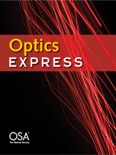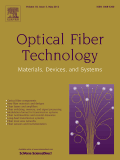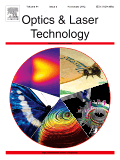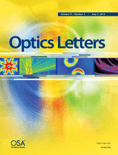
Acta Photonica Sinica
metrics 2024
Shaping the Dialogue in Photonics and Optics
Introduction
Acta Photonica Sinica is a peer-reviewed academic journal published by SCIENCE PRESS, focusing on the fields of atomic and molecular physics and optics. Since its inception in 1997, this journal has provided a crucial platform for researchers and professionals to share cutting-edge findings and advancements in photonics and related areas. Despite its current positioning in the Q4 quartile for both atomic and molecular physics and optics, Acta Photonica Sinica remains a significant contributor to the scholarly community, fostering innovative discussions and collaborations. The journal does not currently offer open access, providing a selective but impactful repository of knowledge for readers in China and beyond. As the scientific landscape evolves, the journal aims to enhance its scope and impact, addressing the challenges and opportunities within the photonics domain. Researchers, students, and professionals interested in the latest theoretical and experimental studies will find a wealth of information that emphasizes the pivotal role of optics in scientific and technological advancements.
Metrics 2024
 0.21
0.21 0.60
0.60 0.50
0.50 25
25Metrics History
Rank 2024
Scopus
IF (Web Of Science)
JCI (Web Of Science)
Quartile History
Similar Journals

Opto-Electronic Advances
Exploring the Intersection of Light and TechnologyOpto-Electronic Advances is a premier open-access journal published by the Chinese Academy of Sciences' Institute of Optics & Electronics, dedicated to advancing the fields of optics and electronic engineering. Established in 2018, this journal quickly ascended to a Q1 ranking across multiple categories including Atomic and Molecular Physics, Electrical and Electronic Engineering, and Electronic, Optical and Magnetic Materials, showcasing its impact and relevance in the scientific community. With an impressive Scopus ranking placing it in the top percentiles for critical fields such as Engineering, Materials Science, and Physics, Opto-Electronic Advances provides a platform for researchers to publish their cutting-edge findings and foster dialogue in an increasingly interdisciplinary area of study. The journal emphasizes innovative research that contributes to practical applications and theoretical frameworks in its domain, making it an invaluable resource for academicians, industry practitioners, and students alike. Embrace the future of opto-electronic research with Opto-Electronic Advances, which has been fully open access since 2021, ensuring that knowledge is widely disseminated without barriers.

Optics is a pioneering open access journal published by MDPI, dedicated to advancing the field of optics and photonics. Since its inception in 2020, the journal has fostered the dissemination of high-quality research and innovative developments in optical sciences, contributing significantly to its community of researchers, professionals, and students in Switzerland and beyond. With an impact factor reflective of its growing prominence, Optics strives to address a diverse scope, encompassing atomic and molecular physics, electronic materials, and broader topics in physics and astronomy. The journal's commitment to open access ensures that cutting-edge research is freely available, promoting collaboration and knowledge-sharing across disciplines. As of 2023, it holds a Q4 ranking in several categories, including Atomic and Molecular Physics, and Optics, which illustrates its evolving role in the academic landscape, positioning it as a valuable resource for those seeking to explore the frontiers of optical technology and its applications.

APPLIED OPTICS
Empowering Discoveries in PhotonicsApplied Optics, published by Optica Publishing Group, is a prestigious journal dedicated to the field of optics and photonics. With an ISSN of 1559-128X and an E-ISSN of 2155-3165, this journal serves as a critical platform for researchers, professionals, and students eager to disseminate innovative findings and advancements in applied optics. Established in 1962, it has maintained a significant presence in the academic community, currently holding a Q2 category ranking in various disciplines including Atomic and Molecular Physics, Electrical and Electronic Engineering, and Miscellaneous Engineering as per the 2023 metrics. The journal's reputation is underscored by its solid Scopus rankings, attesting to its influential research output. While not an open-access journal, it continues to offer vital insights and discussions on the latest research topics that are critical to the advancement of technologies in optics, ensuring accessibility to vital knowledge for those within the field.

OPTICS EXPRESS
Advancing Knowledge in Atomic and Molecular PhysicsOPTICS EXPRESS is a premier peer-reviewed journal published by the Optica Publishing Group, specializing in the rapidly evolving fields of Atomic and Molecular Physics and Optics. With an impressive Q1 ranking in its category and positioned in the 75th percentile among leading journals in Physics and Astronomy, OPTICS EXPRESS serves as a vital platform for disseminating innovative research findings. Since its inception in 1997 and transitioning to Open Access in 1998, the journal has ensured that groundbreaking scientific contributions are accessible to a global audience, fostering collaboration and advancement in optical science. Additionally, with annual publications converging from 1997 to 2024, this journal not only tracks the latest advancements but also shapes the future landscape of optics research. Whether you are a seasoned researcher, a dedicated professional, or a passionate student, OPTICS EXPRESS offers a wealth of knowledge and a commitment to excellence in the optics community.

Optics Continuum
Fostering Collaboration in the World of OpticsOptics Continuum, published by Optica Publishing Group, is a pioneering open access journal dedicated to advancing the field of optics and photonics. Since its inception in 2022, this journal seeks to provide a vital platform for the dissemination of groundbreaking research and innovative developments across several interconnected domains, including electrical and electronic engineering, atomic and molecular physics, and material sciences focused on electronic, optical, and magnetic materials. With impressive rankings in Scopus—placed #384 in Electrical and Electronic Engineering and #109 in Atomic and Molecular Physics—the journal aims to engage a diverse readership comprised of researchers, professionals, and students, promoting collaboration and knowledge exchange. The journal's open access model ensures that cutting-edge research is readily available to all, nurturing an inclusive academic environment. For those interested in staying at the forefront of optics research, Optics Continuum is an essential resource that continuously enriches the global scientific community.

OPTICAL FIBER TECHNOLOGY
Leading the Charge in Optical Fiber InnovationsOPTICAL FIBER TECHNOLOGY is a premier journal in the fields of atomic and molecular physics, optics, control and systems engineering, as well as electrical and electronic engineering, published by ELSEVIER SCIENCE INC. With an ISSN of 1068-5200 and E-ISSN 1095-9912, it offers a platform for disseminating cutting-edge research and developments in optical fiber technology and its applications. The journal has achieved a notable impact, ranking in the second quartile for multiple categories in 2023, including control and systems engineering and electronic, optical, and magnetic materials. By providing a robust avenue for peer-reviewed articles, OPTICAL FIBER TECHNOLOGY caters to a diverse audience of researchers, professionals, and students dedicated to advancing knowledge and innovation in optics and related fields. This respected journal is particularly suited for those seeking to stay updated on the latest technological advancements and research trends, ensuring its relevance in both academic and industrial contexts.

JOURNAL OF RUSSIAN LASER RESEARCH
Navigating the Frontiers of Laser ApplicationsThe Journal of Russian Laser Research, published by Springer, stands as a vital resource for researchers and professionals in the fields of atomic and molecular physics, as well as optics and engineering. With its ISSN 1071-2836 and E-ISSN 1573-8760, this journal has been disseminating groundbreaking research since its inception in 1994, with a dedicated focus on the advancement of laser technologies and their applications. While it currently holds a Q4 classification in both Atomic and Molecular Physics and Engineering categories, its commitment to fostering novel insights and innovative methodologies positions it as a promising platform for emerging studies within these disciplines. Although the journal does not offer open access options, it continues to draw attention with a growing citation index. By publishing diverse research articles, reviews, and critical discussions, the Journal of Russian Laser Research not only enriches academic literature but also serves as a stepping stone for students and professionals seeking to deepen their understanding of laser science and its myriad applications.

OPTICS AND LASER TECHNOLOGY
Cutting-edge Research for a Brighter TomorrowOPTICS AND LASER TECHNOLOGY, published by Elsevier Science Ltd, is a premier journal dedicated to advancing knowledge in the fields of optics and laser applications. With its impressive Q1 rankings across three critical categories—Atomic and Molecular Physics, and Optics; Electrical and Electronic Engineering; and Electronic, Optical and Magnetic Materials—the journal stands at the forefront of scientific discourse, boasting a significant impact factor that underscores its relevance. Since its inception in 1970, the journal has consistently provided a platform for the dissemination of cutting-edge research, key innovations, and reviews that influence both academic study and practical applications. Although it currently does not have open access options, its rigorous peer-review process and inclusion in esteemed indexing services make it a valuable resource for researchers, professionals, and students seeking to stay informed about the latest developments in optics and laser technology. The journal’s ongoing commitment to quality research ensures it remains a vital publication for those engaged in this dynamic field, with a converged projection extending through 2025.

Korean Journal of Optics and Photonics
Exploring the Frontiers of Photonics ResearchKorean Journal of Optics and Photonics is a premier publication dedicated to advancing knowledge in the rapidly evolving fields of optics and photonics. Published by the esteemed Optical Society of Korea, this journal serves as a vital platform for researchers, professionals, and students seeking to disseminate their findings and innovations in areas such as optical engineering, photonics technologies, and application developments. Although the journal does not operate under an Open Access model, it is committed to high-quality peer-reviewed research that contributes significantly to both theoretical and practical advancements in the field. With an increasing focus on interdisciplinary research, the Korean Journal of Optics and Photonics is poised to play a crucial role in fostering collaboration and driving the global conversation on light science and technology. The journal's ISSN is 1225-6285 and it also carries the E-ISSN 2287-321X, ensuring its availability to a wide readership.

OPTICS LETTERS
Exploring New Frontiers in Light and MatterOPTICS LETTERS is a premier academic journal published by the Optica Publishing Group, dedicated to advancing the field of optics and photonics. Since its inception in 1977, it has maintained a strong reputation for publishing high-impact research, holding a distinguished Q1 category ranking in Atomic and Molecular Physics, as well as Optics, making it a vital resource for researchers and professionals alike. With an impressive Scopus rank of #55 out of 224 in its field, OPTICS LETTERS continues to shape the discourse and innovation in optical science. Authors benefit from its extensive international reach, while readers gain access to cutting-edge studies that address both theoretical and applied aspects of optics. Although the journal currently does not offer open access options, its rigorous peer-review standards ensure that every publication meets the highest academic criteria, making it an essential journal for anyone looking to stay at the forefront of optical research.